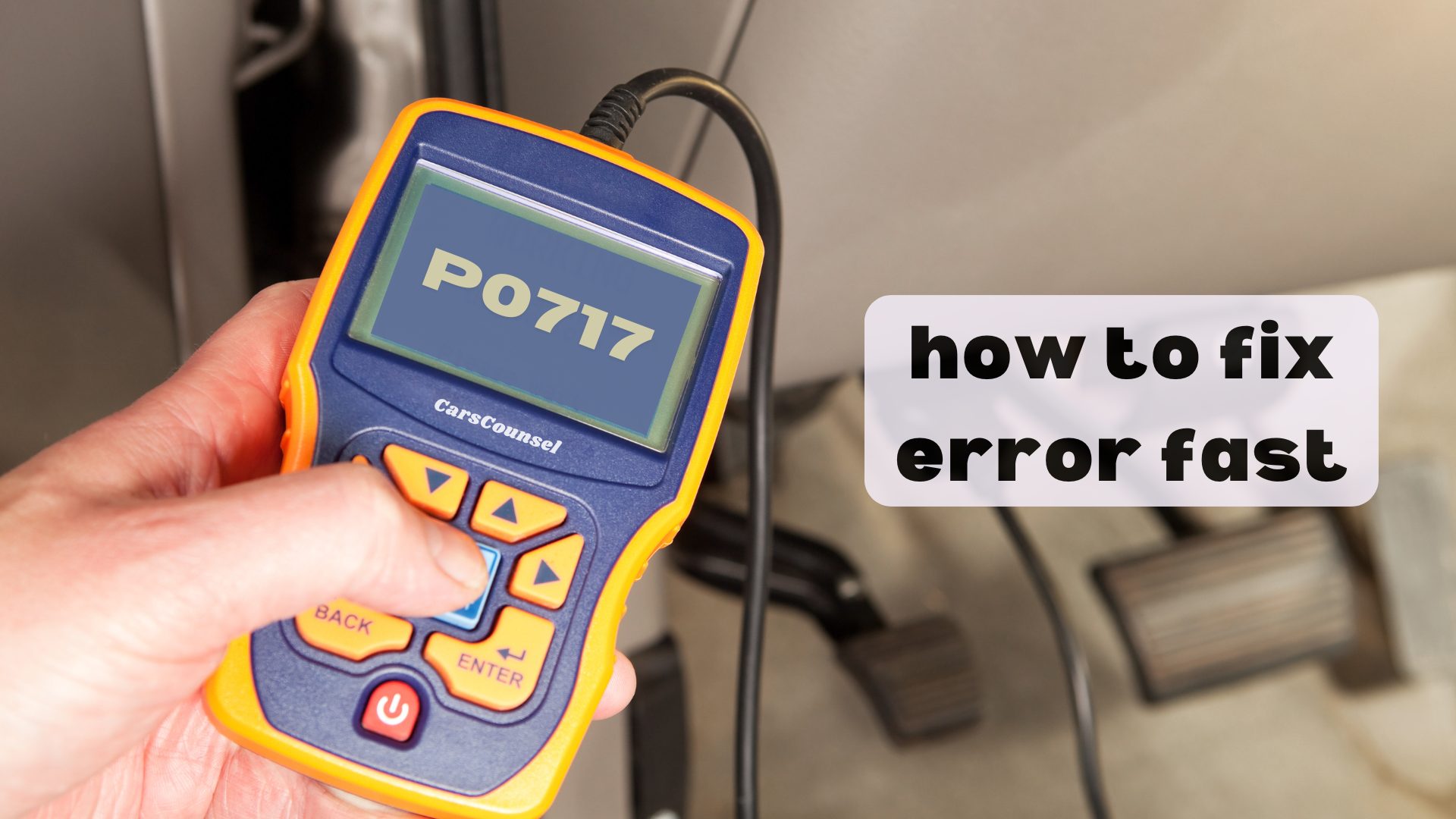If you see a P0717 code, it means there’s an issue with your car’s input turbine speed sensor, which can mess up how your transmission works.
To fix this quickly, follow these steps:
- Inspect the Sensor and Wiring: Look for any visible damage on the sensor and its wires.
- Check the Sensor with a Multimeter: Use a multimeter to test the sensor’s resistance and make sure the wiring is good.
- Replace the Sensor if Needed: If the sensor is broken, you’ll need to replace it.
- Check Transmission Fluid: Bad transmission fluid can affect the sensor, so make sure the fluid is in good condition.
Following these steps can help you fix the problem and avoid future issues.
Want to know more about diagnosing and fixing this error in OBD2 Codes?

Quick Navigation
Key Takeaways
- Replace the broken input speed sensor to get the transmission working right again.
- Look for and fix any damaged or rusty wiring connected to the sensor.
- Make sure the transmission fluid is at the right level and clean.
- Use an OBD2 scanner to check for the P0717 code and find any related problems.
What Is P0717 Code?
The P0717 code means there’s a problem with the input turbine speed sensor, which is important for monitoring the speed of the input shaft to ensure your car shifts gears correctly.
If this sensor isn’t working, it can’t send the right speed information to the transmission control module (TCM). This can cause problems like slipping gears, rough shifting, or even not being able to shift at all.
The sensor helps the TCM adjust gears based on how you’re driving. Without accurate speed data, your car might shift gears unpredictably, use more fuel, and even pose safety risks.
Fixing this issue quickly helps keep your transmission working well and prevents more damage.
Key Symptoms of P0717
If you’re having trouble with your car shifting gears smoothly, it might be due to a P0717 code. Here are some common signs to watch out for:
- Rough or Delayed Shifting: The car feels rough or takes longer when changing gears.
- Transmission Slipping or Jerking: The car unexpectedly slips out of gear or jerks while driving.
- Dashboard Warning Lights: Transmission warning lights on your dashboard turn on.
These problems can make driving difficult, so it’s important to address them quickly.
Impact on Vehicle Performance
A P0717 code can really mess up how your car drives. It can cause rough shifting, lower gas mileage, and even trigger limp mode.
When the input turbine speed sensor fails, it messes with the transmission, causing jerky gear changes. You might notice your car shifts roughly or takes longer to change gears, making driving less smooth.
Your gas mileage can also drop because the engine and transmission aren’t working well together. Plus, the car might go into limp mode, which limits you to one or two gears to avoid more damage.
Having a reliable sensor is crucial for keeping things running smoothly. Fixing the P0717 code quickly makes sure your transmission works right and keeps your car performing well.
Common Causes of P0717
To understand why a P0717 code affects your car’s performance, you need to identify common causes like broken input speed sensors, damaged wiring, or problems with the transmission control module. Fixing these issues quickly can prevent bigger transmission problems.
Here are the top three common causes:
- Broken Input Speed Sensor: Often needs the sensor to be replaced to get the gears shifting properly again.
- Damaged Wiring: Heat or wear can damage the wiring, so repairs are needed to keep the electrical connections working.
- Transmission Control Module Problems: A faulty TCM can mess up transmission operations and might need to be reprogrammed or replaced.
Diagnosing the P0717 Code
When diagnosing the P0717 code, start by visually inspecting the input speed sensor, its wiring, and connectors for any damage or corrosion.
Check that the sensor is properly aligned and connected.
Use a multimeter to test the resistance of the input speed sensor circuit. If the readings are off, you might need to replace the sensor.
Also, check the transmission fluid level and quality; dirty fluid can affect the sensor’s performance.
Use an OBD2 scanner to confirm the P0717 code and look for any related codes.
If needed, adjust the transmission settings, as incorrect settings can impact the sensor readings and overall transmission performance.
Accurate diagnostics are key for effective repairs.
Visual and Electrical Inspections
Doing a thorough visual and electrical check is crucial for figuring out what’s causing the P0717 code.
Start by looking at the sensor and its connections to make sure they’re in good shape. Check for any damage, rust, or loose wires. Keeping the wiring in good condition is important to avoid random problems. Use a multimeter to check if the circuit is working properly.
Here’s a quick checklist:
- Look at the sensor: Make sure it’s clean, firmly attached, and not damaged.
- Check wires and connectors: Look for any wear, rust, or loose connections that could mess up the wiring.
- Use a multimeter: Check the electrical values in the sensor circuit to make sure everything’s working right.
These steps will help you find the problem quickly.
Using OBD2 Scanners
After you’ve checked everything visually and electrically, use an OBD2 scanner to confirm the P0717 code and find any other related issues.
Make sure your scanner works well with your car and has all the necessary OBD2 features. First, connect the scanner to the OBD2 port, which is usually under the dashboard.
Turn on the ignition and follow the scanner’s instructions to get the diagnostic trouble codes (DTCs). The scanner will show the P0717 code and any other errors.
This step is crucial because it helps you understand any deeper problems. Always check that your scanner is compatible with your vehicle for accurate readings and effective troubleshooting.
Effective Fixes for P0717
To fix the P0717 code, follow these steps:
- Replace the Sensor: Swap out the faulty input speed sensor with a new one. This is often the quickest way to solve the issue.
- Check and Fix Wires: Look at the wiring connected to the sensor. Repair any wires that are damaged, worn out, or corroded.
- Check Transmission Fluid: Make sure the transmission fluid is at the right level and isn’t dirty. If needed, flush and replace the fluid.
Preventing Future Errors
Regularly checking your vehicle’s transmission system can help you avoid future P0717 errors. Focus on preventive maintenance to keep your transmission in great shape. Check the transmission fluid levels and quality often, and replace or flush the fluid when needed. Make sure the wiring and connectors are not damaged. Keep your ECM software updated to prevent compatibility problems.
| Task | How Often |
|---|---|
| Check transmission fluid | Every 6 months |
| Inspect wiring/connectors | Every 12 months |
| Update ECM software | As manufacturer says |
Taking good care of your transmission can save you money on repairs and keep your vehicle reliable for a long time. Fix small issues early to avoid bigger problems later. This proactive approach keeps your car running well and prevents P0717 errors from coming back.
Vehicles Prone to P0717
Some car models are more likely to have the P0717 code because of how they’re designed and used. This code usually means there’s a problem with the input turbine speed sensor, which can mess up the transmission. Here are some common culprits:
- Dodge RAM: These trucks often have this issue because heavy-duty use can put a lot of strain on their transmission parts.
- Nissan Altima: This car is known for problems with its CVT (Continuously Variable Transmission), which often leads to input speed sensor troubles.
- Ford Fusion: Some Fusion models have automatic transmissions that are prone to this kind of issue.
Other cars like the Chevrolet Malibu and Toyota Camry also get this error because of sensor-related transmission problems.
Regular maintenance and changing sensors when needed can help keep the P0717 code away in these vehicles.
More OBD-II Codes
Frequently Asked Questions
Can Driving With a P0717 Code Cause Long-Term Damage to My Transmission?
Yes, driving with a P0717 code can damage your transmission. It’s important to get your vehicle checked right away to avoid serious problems like slipping or rough shifting, which can lead to expensive repairs or even total transmission failure.
What Should I Do if My Car Enters Limp Mode Due to P0717?
If your car goes into limp mode because of a P0717 error, take action right away. Check the input speed sensor, look over the wiring, and make sure the transmission fluid levels are correct. This will help get your car back to normal and avoid more damage.
How Expensive Is It to Fix the P0717 Code Issue?
Fixing the P0717 code can cost different amounts. First, you might spend about $100 to $200 just to figure out what’s wrong. If you need to replace the input speed sensor, that usually costs between $150 and $400. However, if there are problems with the wiring, transmission control module (TCM), or transmission fluid, it could end up costing more.
Are There Any Temporary Fixes for the P0717 Code?
About 30% of transmission problems are due to sensor issues. For a temporary fix to the P0717 code, you can try checking and cleaning the sensor connections or clearing the code with an OBD2 scanner. However, these steps won’t address the root causes of the sensor problems.
Does P0717 Code Affect Manual Transmission Vehicles?
No, the P0717 code doesn’t affect manual transmission vehicles. This code is specific to automatic transmissions. You’ll notice issues like rough shifting or the car going into limp mode only in vehicles with automatic transmissions.
Conclusion
You can do this! By addressing the P0717 code directly, you can improve your car’s performance.
Start with a visual inspection or use a multimeter. Replace the faulty sensor and clean your transmission fluid.
Regular maintenance can help prevent this issue in the future. Your car will run smoothly and thank you with every perfect drive.

